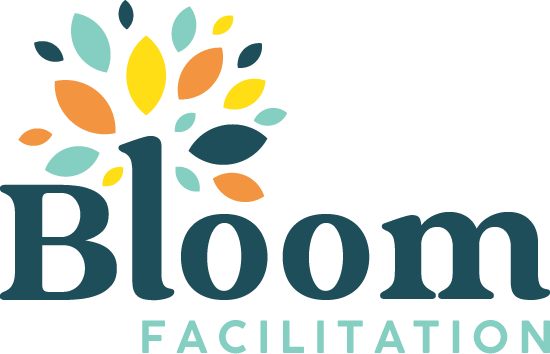Whether you are leading a training workshop or getting into small groups at a meeting, it matters how you as the leader or facilitator divide people into small groups.
But first, Why Small Groups?
“Small groups are the unit of transformation.” Peter Block
When people are in a small group (3-12 people) they are better able to form connections and have a greater degree of intimacy. Practically, it is easier for each person to speak and be heard. However, small groups are also better at self-regulating. If someone isn’t being given a chance to speak, it is more likely that they will be encouraged to speak in a very small group of 3-5 people.
Small groups are great when:
- You need or want everyone’s input.
- You have a lot of work to get done and can divide and conquer.
- The topic is difficult and people may feel more confident and comfortable sharing their opinion in a less intimidating setting.

First Question: How many people and how many groups?
It helps to know how many people you have and how large you want the groups to be. Take a second to do the math to figure out what permutations are possible based on your group size. I am using the example of 24 people, partly to make the math easy. 24 people could divide into:
- 2 groups of 12
- 3 groups of 8
- 4 groups of 6
- 6 groups of 4
- 8 groups of 3
- 12 groups of 2
For most situations you will want a group size between 3 and 6 so that leaves you with the options of:
- 4 groups of 6
- 6 groups of 4
- 8 groups of 3
Second Question: What is your purpose? What type of mix do you want in the groups?
Are you trying to divide the group into random groups, mixed experience groups, or groups with similar experience-level?
First Example: Like Groups
Let’s say you have a group of 24 people and within the group there is a very broad range of experience. You are going to be working on a planning project and you think it would be most efficient to have those with the most experience work together and those who are newest work together. You may even give the groups different versions of the task based on their experience level.
Try This:
Have everyone line up by how many years of experience they have (either in the organization or in the field of work depending on your preference).
Once in a line, they can reintroduce themselves to everyone. Then divide them into groups while still in the line by just separating the line into segments.
[ 1 2 3 4 ] [5 6 7 8] [9 10 11 12] [13 14 15 16] [17 18 19 20] [21 22 23 24]
This will give you 6 groups with 4 people in each group, in which every group is working with people who have a similar amount of experience.
Second example: Diverse Groups
What if you have the same situation as example 1, except that this time you are doing a brainstorming exercise for new ideas for the organization and you want the creativity that comes from diverse groups. Therefore, this time you want to have small groups who have a mix of experience levels.
Try this:
Have everyone line up by how many years of experience they have (either in the organization or in the field of work depending on your preference).
Once in a line, they can reintroduce themselves to everyone. Then have the line count off 1 through 6 starting with the person with the least experience. Then ask them to form groups with the people with the same number as they had (all the ones together, all the twos together, etc.). This will mean that the person who was first in line, with the least experience is going to end up in a group with the person with the 7th, 13th, and 19th least experience.
[ 1 7 13 19] [2 8 14 20] [3 9 15 21] [4 10 16 22] [5 11 17 23] [6 12 18 24]
This will give you 6 groups with 4 people in each group in which every group is work with people with diverse amounts of experience.
Third example (RANDOM):
What if you just need to divide people up in a random way? It is often useful to mix up the group and you want to ensure it is done in a totally random way where you won’t be showing any preference or bias and will be openly random to the participants as well.
Try this: Game Cards
Bring a deck of Uno or Phase 10 cards. You can either use the colors (if you are forming 4 or fewer groups) or the numbers (for up to 12 groups). Prepare the cards ahead of time by pulling out what you need. For example, if you want to have 6 groups, with four people each, you could pull out 4 cards with the number 1, 4 cards with the number 2, 4 cards with the number 3, and so on up to 6.
Then shuffle the cards that you have pulled and hold them face down like you are a dealer or a magician. I find that the participants really like the element of mystery and chance that comes from being able to pull their own card from the deck. I do not tell them why they are pulling a card, I just hold out the deck. It always makes people smile and generates a little energy within the group. Once everyone has a card, I let them know that they can find the other people who have the same number on the card as they have.
You can also order Climer Cards if you want facilitation specific cards that have numbers, colors, and shapes on one side and an abstract watercolor image on the other side. These are used by many professional facilitators, including me.

The front of the cards have beautiful hand-drawn pictures, but the back of the cards have numbers, shapes and colors that would work just like Uno
Get multiple groups from one deal
You can reuse these cards if you plan ahead. For example, if you also make sure that the cards are divided evenly by color, then you could form groups later by color. You could end up with 4 groups of 6 when everyone finds the person with the same color on their card.
I find this to be a more efficient and fun way of dividing up instead of having everyone take time to line up and count off.
Custom cards
If you have a theme or you want to be really creative, you could create your own cards or images.
For example, I was in a group once where we picked a piece of paper from a basket. On the piece of paper was an animal. It turned out that all of the animals were divided into 2 groups: those with feather or those with fur. That was how we knew which group we were in. Furthermore, later in the gathering we were divided once again. This time we were asked whether our animal was extinct or not. Turned out that half of the animals were extinct and half were not.
Fourth Example: RANDOM + Icebreaker
Follow the same practice as example 1 or 2, except instead of lining up by years of experience, line up by something more random, such as their birthday (only the day, not the year). You would have everyone in a line from January through December. People enjoy finding out that they have a birthday near or on the same day as someone else in the group, so this can double as a simple way to make introductions at the beginning of a meeting or workshop.
Fifth Example: Predetermined
Create name badges or folders for the participants. Put stickers on them ahead of time that either have different colors or different designs. This allows you to divide the group by whatever combination you want. You can really give some thought to who should be in what group ahead of time. It’s sort of like preparing a seating chart for a wedding. You have all the power!!

Sixth Example: Random + Fun and Movement
Get a win-win by pairing movement with the logistics of dividing into groups.
One game I like to use is called “Find Somebody Who”.
It’s a great icebreaker.
You call out a characteristic like, “find somebody who has the same number of siblings you do”. You let them know that they can’t form groups bigger than a certain amount (usually 4 or 5). Once they form groups with that criteria you can give them something to do in that group, such as answer a question. Then repeat the same activity for another round with a new criteria like, “Find somebody who shares the same hobby or sport as you do.” You can keep this going for 3 or 4 rounds to have them continue to mix up into different small groups.

Are you interested in more ideas for facilitating meetings and gatherings? Check out our other articles on Meeting Facilitation.
